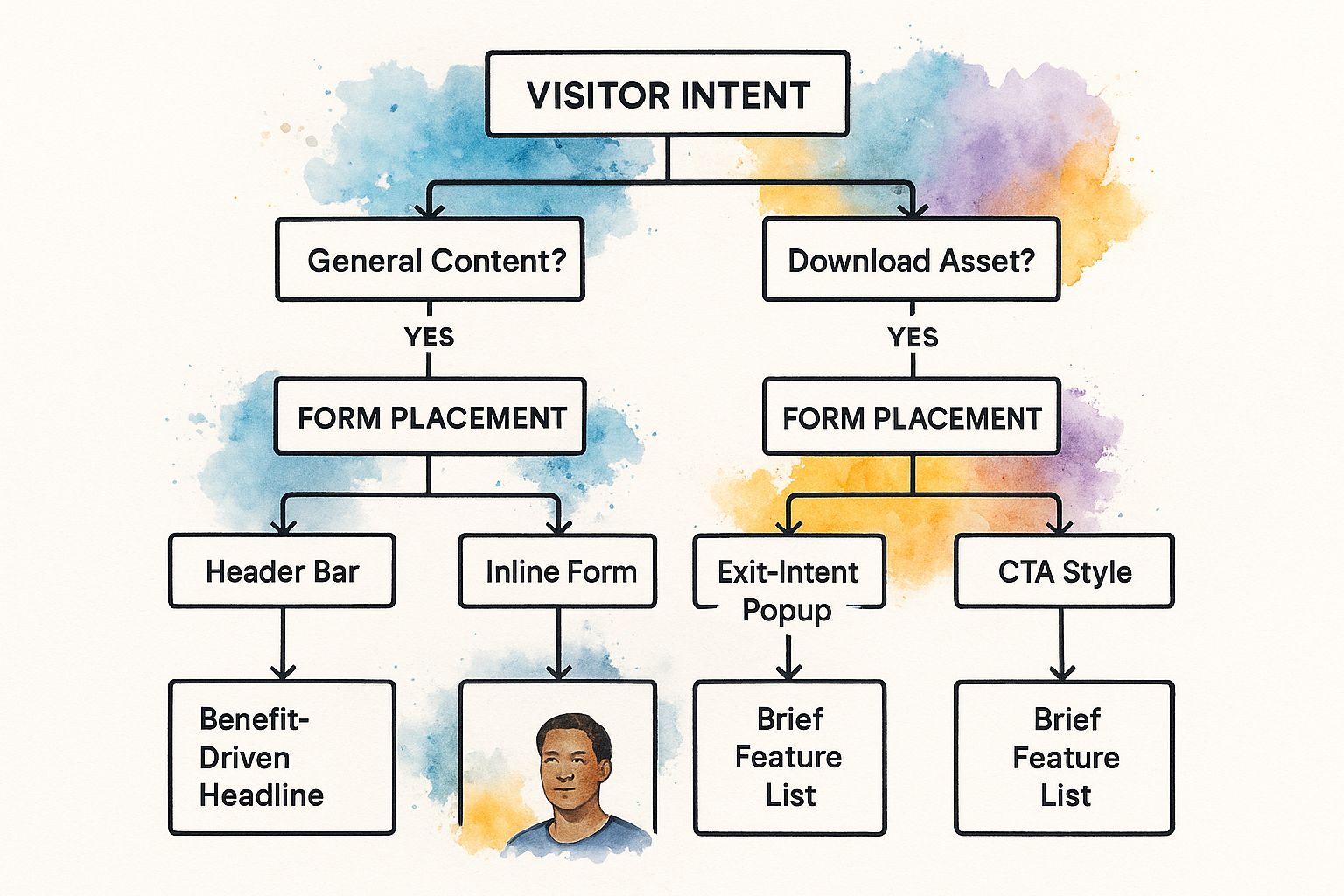Building an email list isn't just about collecting addresses. It's about forging a direct connection with your audience through smart offers, easy-to-use signup forms, and—most importantly—consistent value. You're attracting the right people with content they actually want, getting their permission to stay in touch, and then building that relationship over time.
Why Your Email List Is a Core Business Asset

Before we get into the how, we have to talk about the why. It's a big deal.
Social media is great for getting discovered, but you’re ultimately building your business on rented land. Algorithms change without warning, accounts get suspended for mysterious reasons, and platforms fall out of fashion. When that happens, your connection to the audience you worked so hard to build is suddenly at risk.
An email list is different. It's an asset you truly own and control.
Think of it like a private phone book filled with people who have literally raised their hands and said, "Yes, I want to hear from you." This direct line of communication is completely immune to the whims of third-party platforms. When a social network has an outage, your ability to reach your most engaged followers doesn't skip a beat.
The Unmatched Value and ROI of Email
That stability is just one piece of the puzzle. From a financial standpoint, email marketing delivers one of the most incredible returns you'll find anywhere. The proof is in the numbers: email marketing generates an average of $42 for every $1 spent, according to 2025 industry data.
That kind of ROI makes building a list less of a "nice-to-have" and more of a strategic imperative. And with the number of global email users expected to hit 4.8 billion by 2027, its relevance is only growing.
The real power of an email list is its reliability. It's a consistent, predictable channel for driving traffic, generating sales, and building a loyal community—all without being dependent on a single social media trend.
Real-World Success and Ownership
Businesses that make their email list a priority are building a much more resilient foundation for growth. For a fantastic real-world example, check out how Lynd Fruit Farm grew their list to 43k. Their story is a perfect illustration of how a dedicated list can become a powerhouse for sales and engagement, no matter what's happening in the wider market.
Ultimately, this asset gives you a direct, unfiltered connection to your audience. It allows you to deliver value and drive your business forward, completely on your own terms.
Creating Lead Magnets People Genuinely Want

A powerful email list starts with an irresistible offer. This free resource, what we call a lead magnet, is the ethical bribe you give someone in exchange for their email address. The quality of that bribe directly impacts the quality of your subscribers and sets the tone for your entire relationship.
Forget the generic, 5-page eBook that just rehashes common knowledge. Your goal isn't just to get an email. It's to deliver an instant win that makes your new subscriber think, "Wow, if their free stuff is this good, I can't wait to see what else they offer."
This immediate value is how you build trust and prove your expertise right from the get-go.
Moving Beyond Generic Ebooks
To create a lead magnet that actually works, you have to get inside your audience's head and figure out their most pressing problems. What's the one roadblock they face that you can help them smash through right now? The answer to that question is your perfect lead magnet.
Think in terms of practical, high-utility formats that save your audience time, money, or a massive headache.
- Custom Checklists: A "Podcast Launch Checklist" is infinitely more useful for a new creator than a vague guide on podcasting. It’s a clear, step-by-step roadmap.
- Plug-and-Play Templates: A social media manager would kill for a pre-built "Monthly Content Calendar Template." It’s a tool they can put to work immediately.
- Exclusive Video Workshops: Offer a short, focused video tutorial, something like a "15-Minute SEO Audit for Beginners," that solves a specific technical challenge.
- Curated Resource Libraries: Compile your top-rated tools, articles, and resources on a specific topic. This saves your audience hours of painful research.
The best lead magnets solve a very specific problem with a very specific solution. They provide a quick, tangible result that makes your new subscriber’s life easier in a measurable way.
Pinpointing Your Audience's Pain Points
Not sure what problem to solve? The clues are probably hiding in plain sight within your own content and community feedback. You just need to know where to look.
Start by digging into your analytics to find your most popular blog posts. If an article on "email subject lines" is getting a ton of traffic, a killer lead magnet would be a downloadable list of "50 High-Converting Subject Line Formulas." You're tapping directly into a proven interest.
Your comment section and social media DMs are another goldmine. What questions pop up over and over again? If you're constantly asked how to set up a certain tool, a "Quickstart Configuration Guide" would be a no-brainer.
Finally, when in doubt, just ask. Run a poll on social media or send a survey to your existing contacts asking about their single biggest challenge in your industry. This direct feedback is invaluable. When you create a solution to their exact stated problem, the decision to subscribe becomes effortless.
Designing Opt-in Forms That Convert Visitors
You've got an amazing lead magnet ready to go. So, how do you actually get it in front of people? This is where the art and science of designing and placing your opt-in forms comes into play. The goal is to grab attention and get that click, all without wrecking the user experience.
Think of your opt-in form as more than just a box for an email address. It's the handshake that turns a casual visitor into an engaged subscriber. The design, the words you use, and where you put it all send subtle signals about the value you’re offering. Get it right, and you'll build a list of people who are genuinely eager to hear from you.
Finding the Right Placement and Format
The best spot for your form isn't a one-size-fits-all answer. It really depends on what a visitor is trying to do on any given page. You wouldn't throw the same aggressive pop-up on a casual blog reader that you would on someone visiting a product page. The key is to match the form’s assertiveness with the visitor’s mindset.
This decision tree gives you a good visual for how to think about placing your forms based on what the visitor is likely there for.

As you can see, a visitor just browsing your blog might respond best to a subtle inline form. But someone who clicked an ad to download a specific resource? They're primed for a more direct approach, like a dedicated landing page that has one job: get the signup.
Here are a few of the most effective formats I've seen work time and again:
- Header Bar: This is a thin bar that sticks to the top of your site as users scroll. It’s always there but not obnoxious, which makes it perfect for site-wide offers.
- In-Content Forms: These are forms you embed right in the middle of a blog post or page. They work like magic when the offer is a "content upgrade" that's hyper-relevant to what the person is already reading.
- Exit-Intent Pop-ups: This form only shows up when a user’s cursor moves like it's about to leave the page. It's your last-ditch effort to convert a visitor, usually with a really compelling, can't-say-no offer.
- Dedicated Landing Pages: If you have a high-value lead magnet or are running paid ads, a dedicated landing page is non-negotiable. It strips away all the usual navigation and distractions, focusing the visitor on one single action: signing up. To get this right, check out our complete guide on building high-converting landing pages.
Crafting a Compelling Call to Action
Your form's headline and the text on your call-to-action (CTA) button are the two most critical pieces of copy. They have to communicate the benefit in a split second. Forget a generic "Subscribe Now." Instead, try something that focuses on what they get, like "Get My Free Checklist" or "Send Me the Cheatsheet!"
Keep your forms dead simple. Every extra field you ask someone to fill out creates friction and will tank your conversion rates. Unless you have a very good reason, just ask for the email address.
With the number of email users expected to hit 4.6 billion by 2025, building a quality list is still one of the smartest things you can do for reliable outreach. Unlike social media, where algorithms are king, your email list is a direct channel to your audience. On average, it drives 40 times more customer acquisition than platforms like Facebook and Twitter. This direct ownership is why sweating the small stuff—like every single element on your opt-in form—is such a high-leverage activity for your business.
Choosing Your First Email Marketing Platform
Picking the right Email Service Provider (or ESP) is one of the very first hurdles you'll face. This isn't just another tool; it's the command center for your entire email operation. It's where you'll manage subscribers, design emails, and set up the automated sequences that work for you while you sleep.
The right choice makes your life easier. The wrong one? Constant headaches.
But here’s the thing: your decision shouldn't be about finding the platform with a million features. It’s about finding the one with the right features for you, right now. The needs of a freelance writer are worlds apart from a booming ecommerce store. A writer might just want simple tagging and clean broadcast emails, while the store owner needs advanced automation tied to customer purchase history.
What Features Truly Matter at the Start
It's so easy to get distracted by shiny, complex features you won't touch for months, maybe ever. Instead, let's zero in on the core components that will actually help you grow from day one without a massive learning curve.
Here's what to look for:
- Ease of Use: This is huge. Can you get in there and figure out how to build a basic email without needing a four-hour YouTube tutorial? A clean, intuitive dashboard is your best friend.
- Reliable Deliverability: Your emails need to land in the inbox, period. Not the spam folder. Stick with platforms known for high deliverability rates.
- Simple Segmentation: At a minimum, you'll want the ability to "tag" subscribers based on how they signed up. This is the first step toward sending more relevant content down the line.
- Basic Automation: A non-negotiable. You need to be able to set up a simple, automated welcome email or a short series for new subscribers. This is how you start building a relationship from the moment they join.
Here's a secret: your first ESP doesn't have to be your forever ESP. The goal is to pick something that fits your budget and technical comfort level today, while giving you room to grow.
Matching the Platform to Your Business Model
Let's make this real. A blogger who writes about different topics might love a platform like ConvertKit, which is built around tagging subscribers based on their interests. On the flip side, someone running a Shopify store would get a ton of value from a tool like Klaviyo that integrates deeply with their sales data.
Once you have a general idea, you need to dig in and compare the best email marketing platforms to find the one that truly clicks with your goals.
To help you get a clearer picture, I've put together a quick comparison of what different types of platforms excel at. This isn't about naming a single "best" tool, but about matching the tool to the job.
Email Service Provider Feature Comparison
| Feature | Beginner-Friendly (e.g., Mailchimp) | Advanced Automation (e.g., ActiveCampaign) | Creator-Focused (e.g., ConvertKit) |
|---|---|---|---|
| User Interface | Very visual, drag-and-drop editor. Great for those new to email marketing. | More complex with powerful workflow builders. Steeper learning curve. | Clean and simple, focused on writing and content delivery. |
| Automation | Basic welcome emails and simple multi-step sequences. | Highly advanced "if-then" logic, goal tracking, and lead scoring. | Visual automations designed for content creators (e.g., tagging based on link clicks). |
| Segmentation | Good for basic list segmentation and simple groups. | Extremely granular segmentation based on user behavior, site visits, and more. | Tag-based system that is very flexible for segmenting by interest or actions taken. |
| Pricing Model | Offers a generous free plan, but can get expensive quickly as you grow. | More expensive from the start, but pricing scales with advanced features. | Pricing is based on subscribers; no free plan but offers great value for creators. |
| Best For... | Small businesses, local shops, or anyone needing a simple, all-in-one solution to start. | E-commerce stores, SaaS companies, and businesses that need sophisticated marketing funnels. | Bloggers, podcasters, YouTubers, and anyone building an audience around their content. |
This table gives you a starting point, but nothing beats hands-on experience.
Don't fall into the trap of "analysis paralysis." Most of the top platforms offer free trials or very generous free plans. Sign up for two or three that seem like a good fit. Spend an hour with each one: build a test opt-in form and create a simple welcome email.
That direct experience will tell you more than any feature chart ever could. Go with the one that feels the most comfortable and get moving.
Driving Consistent Traffic to Your Opt-in Offers

So, you've built an amazing lead magnet and a sharp-looking opt-in form. That’s a huge win. But here's the hard truth: even the most irresistible offer is totally useless if no one ever sees it.
Your next mission is to build a system that drives a steady stream of qualified traffic right to those sign-up opportunities. This isn't about crossing your fingers and hoping people stumble upon your forms. It’s about being proactive and weaving list-building into the very fabric of your marketing. The idea is to create multiple pathways that all lead back to your email list.
Leverage Your Existing Content
Your most valuable traffic-driving assets are the ones you already own. Think of your existing content as a goldmine for promoting your lead magnet to a warm audience—people who already know and trust you.
A great place to start is with your top-performing blog posts, the ones that consistently pull in the most organic search traffic. These articles are proven winners. You can make them even more powerful by adding a content upgrade—a super-specific bonus that perfectly complements the topic. For instance, if your most popular post is about launching a podcast, the upgrade could be a simple "Podcast Launch Gear Checklist."
Here's how to put your content to work:
- Mention Your Lead Magnet: Weave a casual reference to your main lead magnet into relevant articles. A simple, "If you're ready to go deeper on this, grab my free video workshop..." can be surprisingly effective.
- Update Old Posts: Go through your archives and strategically add calls-to-action for your new lead magnet where they make sense.
- Use Your Bio: Make sure your author bio on your own blog—and any guest posts you write—includes a direct link to a landing page for your best lead magnet.
Tap Into New and External Audiences
Once you’ve optimized your own properties, it's time to branch out. Tapping into other people's audiences is one of the fastest ways to get your brand in front of a whole new set of potential subscribers.
Guest posting on respected industry blogs is a classic strategy for a reason: it works. Write a genuinely valuable article for a site your ideal subscribers already read, and then use your author bio to point them toward your lead magnet. It's a double-win that builds both your authority and your email list.
Collaborations are a powerful list-building accelerator. When you partner with another creator, you're not just getting traffic; you're getting a warm introduction and an implied endorsement, which dramatically increases trust and sign-up rates.
Here are a few other collaborative ideas to consider:
- Joint Webinars: Team up with a complementary business to host a free educational webinar. Both of you promote the event to your audiences, and everyone who registers gets added to both lists (with clear disclosure, of course).
- Podcast Interviews: Appearing as a guest on relevant podcasts is a fantastic way to share your expertise. At the end of the show, you can direct listeners to a specific landing page to download a related resource you mentioned.
- Targeted Ad Campaigns: For a more direct route, running paid ads on platforms like Facebook or Google can be highly effective. The key is to send ad traffic to a dedicated landing page built for one thing only: converting visitors into subscribers for your lead magnet. For a deeper dive on attracting the right kind of traffic with this method, grab our free AI SEO checklist.
Getting that new subscriber notification feels great, but it’s just the starting line. The real work—building a genuine relationship—begins the moment someone hits "subscribe."
Your first few emails are critical. They set the tone for everything that follows and pretty much decide whether you become a welcome sight in their inbox or just another piece of digital noise.
A single, generic "thank you" email just doesn't cut it anymore. To make a real impact, you need an automated welcome sequence. This is a series of emails that does way more than just deliver your lead magnet. It's your one big chance to show off your brand's personality, provide immediate value, and prove to new subscribers they made the right call.
Designing a High-Impact Welcome Series
Your welcome sequence should feel less like a transaction and more like the beginning of a good conversation. It's the perfect spot to guide your new subscriber and flex your expertise right out of the gate.
A simple, three-part series is often all you need. Here's a structure that works wonders:
- The Instant Delivery: This first email needs to go out immediately. Its main job is to deliver the promised lead magnet. Keep it short, friendly, and laser-focused on getting them their download without any fuss.
- The Story and Connection: Send this one a day later. This is where you tell your story. Why did you start your business? What problem are you obsessed with solving? This helps build a personal connection and shows the human behind the brand.
- The Quick Win: On day three, send an email with a single, actionable tip that helps them solve another small problem. This is all about delivering unexpected value and cementing your role as a helpful expert.
The magic of a good welcome sequence is that it trains your new subscribers to open your emails. By delivering immediate value and engaging content, you create a positive habit from the very beginning.
Using Early Engagement for Smarter Segmentation
That welcome series isn't just for making friends—it's also a powerful tool for segmentation. By tracking who opens your emails and which links they click, you can start understanding their interests from day one.
For example, did they click a link to a specific blog category? You can automatically tag them with that interest. This simple action is the first step toward building an email list that actually responds to what you send.
This early data is gold. Even with today's crowded inboxes, 88% of users check their email multiple times a day. And get this: campaigns tailored to specific segments see 30% more opens and 50% higher click-through rates than generic blasts. Welcome emails, in particular, are superstars, with an average open rate of 51%.
This early intel helps you make sure every future email feels relevant, which is how you turn a brand new lead into a loyal fan. To dive deeper into advanced content and engagement tactics, check out the resources over on the RebelGrowth blog.
Still Have Questions About List Building?
Even with a solid plan, you're bound to run into a few questions once you start building your email list. It happens to everyone. Let's walk through some of the most common ones I hear to get you unstuck and moving forward.
How Long Should My Emails Be?
There’s no single magic number, but when in doubt, go shorter. Always. Think conversational and easy to scan. Most of your subscribers are checking their email on a phone, probably while doing five other things.
A good rule of thumb is to keep the core message between 50 and 125 words.
If you've got a longer story or a big update, don't try to cram it all into the email. Just write a short, punchy intro that gets them curious, then link out to the full post on your blog. It’s a win-win: you respect their time, and you drive traffic back to your site.
Is It a Good Idea to Buy an Email List?
Let me be crystal clear: Never.
Buying an email list feels like a shortcut, but it's actually a fast track to destroying your sender reputation. These lists are just a collection of cold, unverified contacts who never, ever asked to hear from you.
Send to a purchased list, and you'll see abysmal open rates and a flood of spam complaints. Before you know it, email providers will blocklist your entire domain. Building your list organically is slower, yes, but it means you have an audience that actually wants to be there. And that's the whole point.
Your email list's value comes from permission and engagement, not size. A small, active list of 500 subscribers who love your content is infinitely more valuable than a purchased list of 50,000 strangers who will mark you as spam.
Remember, every single subscriber needs to have explicitly opted in. That consent is the bedrock of a healthy—and profitable—email marketing strategy.
Ready to turn your website traffic into a powerful asset? rebelgrowth gives you the AI-powered tools to create compelling content, manage your marketing, and grow your email list faster. Explore our full suite of tools at https://rebelgrowth.com.
